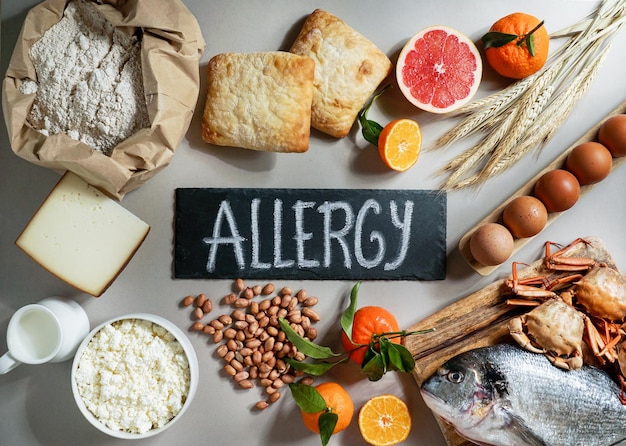1) Introduction
Food allergies and intolerances are often confused, but they differ significantly. A food allergy triggers an immune response, while intolerance affects digestion. Understanding this distinction is crucial to avoid unnecessary dietary restrictions and ensure proper management.
Why Understanding the Difference Is Important? Knowing the difference between allergies and intolerances helps people take appropriate actions for their health. Allergies can be life-threatening, while intolerances typically cause discomfort but are less dangerous.
Rising Awareness around Food Allergies and Intolerances: The prevalence of food allergies and intolerances is increasing globally. As more people experience reactions, awareness has risen. Schools, restaurants, and food manufacturers now prioritize allergy-friendly options, improving the safety and well-being of affected individuals.
This growing awareness emphasizes the importance of understanding food-related reactions and how to manage them.
2) What Are Food Allergies?

Food allergies occur when the immune system mistakenly identifies certain foods as harmful. This triggers an immune response.
- How does the Immune System respond to Food Allergens? When a person with a food allergy consumes an allergen, their immune system releases chemicals like histamine. This causes allergic reactions.
- Common Symptoms of Food Allergies: Symptoms of food allergies can range from mild to severe. Mild symptoms include hives, itching, and swelling. Severe reactions can lead to difficulty breathing, anaphylaxis, or even shock.
- Examples: Some common food allergens include peanuts, tree nuts (such as almonds and walnuts), shellfish, and fish. Dairy, eggs, soy, and wheat are also frequent triggers.
Understanding food allergies is essential for managing symptoms and avoiding potential reactions. If you suspect a food allergy, seek medical advice.
3) What Are Food Intolerances?
Food intolerances occur when your body struggles to digest certain foods. Unlike food allergies, they do not involve the immune system. Instead, food intolerances arise due to digestive issues, such as lacking enzymes needed to break down certain foods.
- Difference between Food Intolerances and Food Allergies: Food intolerances are often confused with food allergies. However, they are different. Food allergies trigger the immune system, which can lead to severe reactions. Food intolerances, on the other hand, only affect digestion and cause less severe symptoms.
- Common Symptoms: The symptoms of food intolerances typically include digestive issues like bloating, gas, stomach pain, and diarrhea. These symptoms can develop several hours after consuming the food. They are often uncomfortable but not life-threatening.
- Examples: Some common food intolerances include lactose intolerance and gluten intolerance. Lactose intolerance occurs when your body lacks the enzyme lactase to digest dairy products. Gluten intolerance, or non-celiac gluten sensitivity, involves difficulty digesting gluten, a protein found in wheat, barley, and rye.
Recognizing food intolerances can help you avoid discomfort and make better food choices for your health.
4) Key Differences between Allergies and Intolerances
Understanding the differences between allergies and intolerances is essential for proper diagnosis and treatment. Both affect how your body reacts to certain foods, but they vary significantly in how they work.
- Immune System Involvement: Food allergies involve the immune system. When you eat an allergen, your immune system triggers a reaction, mistaking it for a harmful substance. Food intolerances, however, do not involve the immune system. They occur due to difficulty digesting certain foods.
- Severity and Symptom Onset: Allergies can cause severe symptoms, including anaphylaxis, which is life-threatening. Symptoms usually appear quickly after consuming the allergen. Intolerances are generally less severe and affect digestion, such as bloating or discomfort. Symptoms often take longer to appear and are not life-threatening.
- Long-Term Health Implications: Allergies pose serious health risks, requiring strict avoidance of triggers. Repeated exposure can worsen reactions over time. Intolerances usually don’t lead to long-term damage but can affect quality of life by causing discomfort.
- How Both Are Diagnosed: Allergies are diagnosed through blood tests or skin prick tests, measuring immune responses to specific allergens. Intolerances are harder to diagnose and may require an elimination diet or breath tests to identify triggers.
5) Latest Research and Trends in Food Allergies and Intolerances
Food allergies and intolerances are on the rise globally, prompting research into better diagnostics, treatments, and food options. Here are the latest trends and advances shaping the field.
- Advances in Diagnostic Testing: New diagnostic tests offer more accurate results for food allergies and intolerances. Researchers have developed tests that identify specific proteins triggering allergic reactions. Blood and skin tests are now more sensitive, helping doctors provide tailored treatment plans.
- Emerging Treatments for Allergies: Oral immunotherapy (OIT) is one of the most promising treatments for food allergies. It involves introducing small amounts of the allergen to the immune system. Over time, the body becomes desensitized. OIT is showing great results for peanut, egg, and milk allergies. Another treatment approach gaining attention is the development of biologic drugs, which target immune system responses.
- Prevalence and Growth Statistics: Food allergies and intolerances are increasing worldwide. According to the latest statistics, up to 10% of the global population may be affected by food allergies. Intolerances, especially of gluten and lactose, are also on the rise. Researchers are exploring the reasons for this growth, including environmental factors and changes in diet.
- Innovations in Allergy-Friendly Foods: Demand for allergy-friendly and free-from foods is growing. Food companies are innovating to offer more safe and healthy options for people with food sensitivities. Products labeled gluten-free, dairy-free, and nut-free are now widely available. Additionally, alternative ingredients like oat milk, coconut flour, and soy-based products are becoming more popular.
Summary:
With advances in diagnostics, treatments, and food innovations, the future looks promising for people managing food allergies and intolerances. Staying informed about the latest research can help improve quality of life.
6) How to Manage Food Allergies?
- Identifying Allergens and Reading Labels: The first step in managing food allergies is identifying the allergens that trigger reactions. Always read labels carefully to spot potential allergens. Check for hidden ingredients or traces of allergens in processed foods. Many products include common allergens like nuts, gluten, dairy, and soy. Always choose products clearly labeled as allergen-free to avoid accidental exposure.
- Tips for Safe Eating at Restaurants and While Traveling: Eating out or traveling with food allergies can be challenging, but it’s manageable with precautions. When dining at restaurants, inform the staff about your allergies. Ask about cross-contamination risks and ingredient details in dishes. While traveling, pack safe snacks and meals to avoid unsafe options. Research local cuisines and allergen-free restaurants in advance.
- Carrying Epinephrine Auto-Injectors: Always carry an epinephrine auto-injector if you have severe food allergies. This life-saving device should be easily accessible at all times. Make sure it’s not expired, and know how to use it properly. Having it ready in emergencies can prevent severe allergic reactions from escalating.
- Educating Others About Your Food Allergies: Educating those around you about your food allergies is crucial for your safety. Inform schools, workplaces, and family members about the potential risks. Provide them with clear instructions on how to avoid allergens and what to do in case of an emergency.
By following these tips, you can manage food allergies safely and effectively.
7) How to Manage Food Intolerances?

Managing food intolerances can be challenging, but with the right approach, it becomes manageable. By identifying trigger foods and making adjustments, you can reduce symptoms and enjoy a varied diet.
- Food Elimination and Reintroduction Diets: Elimination diets are effective for identifying food intolerances. Start by removing suspected trigger foods for a few weeks. After that, slowly reintroduce them one at a time. Track symptoms to pinpoint the problematic foods. This method helps identify intolerances accurately and prevents unnecessary dietary restrictions.
- Alternative Foods and Substitutes: Finding alternatives to common trigger foods is essential. For example, those intolerant to dairy can try almond, coconut, or oat milk. Gluten-free grains like quinoa or rice are excellent substitutes for wheat. Ensure your diet remains balanced by choosing nutrient-rich alternatives.
- Importance of Gut Health and Digestive Enzyme Supplements: Maintaining gut health is crucial for managing food intolerances. Probiotics and prebiotics support a healthy gut environment. Digestive enzyme supplements can help break down foods that are difficult to digest. These supplements ease symptoms like bloating and discomfort after meals.
- Lifestyle Tips to Reduce Symptoms: Simple lifestyle changes can make a big difference. Eat smaller, more frequent meals to reduce digestive strain. Chew food thoroughly and avoid rushing through meals. Stay hydrated and exercise regularly to support digestion. Mindful eating practices can also help manage intolerances more effectively.
By following these strategies, managing food intolerances becomes easier, allowing you to enjoy meals with fewer symptoms.
8) Allergy-Friendly Diets:
Finding the right foods for an allergy-friendly diet can be challenging. But knowing what to look for helps. This guide will cover key alternatives and certifications to look for.
- Common Free-From Products: Free-from products are designed to avoid allergens. Common options include gluten-free, dairy-free, and nut-free items. These products help those with food sensitivities enjoy a safe, nutritious diet. Always check labels to confirm ingredients.
- Gluten-Free, Dairy-Free, Nut-Free Alternatives: For gluten-free diets, look for items made with rice, quinoa, or corn. Dairy-free alternatives include almond milk, coconut yogurt, and vegan cheese. Nut-free products often replace nuts with seeds or seed butter. These alternatives provide the same taste and nutrition without triggering allergies.
- Recommended Brands and Certifications: To ensure quality and safety, check for specific certifications. Look for the gluten-free label or “Certified Gluten-Free” for celiac-safe options. Vegan certifications ensure products are free of dairy, eggs, and animal byproducts. Non-GMO labels guarantee the food contains no genetically modified organisms. Brands like Enjoy Life, Bob’s Red Mill, and So Delicious offer a wide range of allergy-friendly products.
Summary:
An allergy-friendly diet is easier when you know what to look for. By choosing the right free-from products, safe alternatives, and trusted brands, you can enjoy a diverse, safe diet. Always consult product labels and trusted certifications to stay informed.
9) Intolerance-Friendly Diets:
Navigating food intolerances can be challenging, but with the right guidance, it’s manageable. Whether you’re dealing with lactose, gluten, or FODMAP sensitivity, options are available.
- Lactose-Free Diet: Lactose intolerance is common, causing digestive discomfort. A lactose-free diet eliminates dairy or replaces it with lactose-free alternatives like almond or soy milk. Many lactose-free dairy products are also available, ensuring you don’t miss out on essential nutrients like calcium and vitamin D.
- Low FODMAP Diet: A low FODMAP diet helps manage digestive disorders, particularly irritable bowel syndrome (IBS). It limits foods like onions, garlic, and certain fruits that can cause bloating or discomfort. It’s crucial to work with a healthcare professional to balance this diet while ensuring you’re meeting all nutritional needs.
- Gluten-Free Diet: Gluten intolerance or celiac disease requires avoiding foods with gluten, like wheat, barley, and rye. Opt for gluten-free grains such as rice, quinoa, and oats. Many gluten-free alternatives are available, making it easier to maintain a balanced diet.
- Balancing Nutrition with Restrictions: With dietary restrictions, nutrient deficiencies are a concern. Including a variety of whole foods ensures a well-rounded diet. Supplements like digestive enzymes can help improve digestion and nutrient absorption.
- Recommended Supplements: For lactose intolerance, lactase supplements are effective. Digestive enzyme supplements support those on a low FODMAP or gluten-free diet by aiding digestion and nutrient absorption.
By carefully managing food choices and supplements, navigating an intolerance-friendly diet becomes much easier.
10) When to Seek Medical Advice for Food Allergies and Intolerances?

- Signs: Recognizing severe allergic reactions is critical. Common signs include swelling, difficulty breathing, and a rapid heartbeat. If you notice these symptoms, seek emergency medical help immediately. Delayed treatment can lead to life-threatening complications like anaphylaxis.
- Consultation: If you suspect you have a food allergy or intolerance, consult a healthcare professional. Self-diagnosing can lead to mismanagement and increased risk. A doctor will help you identify the problem and guide you on the best course of action. Early consultation can prevent severe reactions and ensure proper management.
- Testing Options for Diagnosis: There are several testing options available for diagnosing food allergies and intolerances. Blood tests measure your immune system’s response to specific foods. Skin prick tests can quickly identify common allergens by observing skin reactions. Elimination diets are also effective, helping pinpoint food triggers through a gradual reintroduction process.
Summary:
It’s essential to consult a healthcare professional when dealing with food allergies or intolerances. Professional diagnosis ensures accurate treatment and long-term management. Testing options like blood tests, skin prick tests, and elimination diets can help you identify your triggers.
11) Conclusion
In summary, understanding food allergies and intolerances is crucial for maintaining health. Always identify potential triggers and consult healthcare professionals. Education about specific allergens can prevent severe reactions.
Staying informed is key. Regularly review ingredient labels and be aware of cross-contamination risks. Educating friends and family about your allergies helps create a safer environment.
Being proactive can significantly improve your quality of life. Consider keeping a food diary to track symptoms and identify patterns. Additionally, explore alternative foods to ensure balanced nutrition.
Finally, managing food allergies and intolerances requires diligence and awareness. With the right strategies, you can enjoy diverse meals without worry. Remember, support groups and online communities can offer valuable resources. They can share experiences and tips for living well with food allergies.
Stay informed, stay safe, and embrace a fulfilling lifestyle. With proactive management, you can navigate daily challenges while enjoying your favorite foods. Empower yourself with knowledge and make informed choices. Your health and well-being depend on it.
12) FAQs
Common food allergens include peanuts, tree nuts, milk, eggs, wheat, soy, fish, and shellfish.
Food allergies involve the immune system, while intolerances affect digestion and do not involve immune response.
Consider almond milk for dairy, quinoa for gluten, and chickpea flour for wheat. Explore safe substitutes.
Keep a food diary and note symptoms. Consult a healthcare professional for proper testing.
Yes, food allergies can develop at any age, even if you previously consumed the food without issues.


